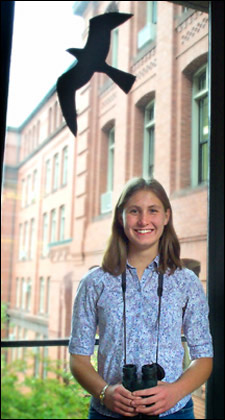On a wing and a prayer
Junior acts like ornithological Sherlock Holmes to save the lives of untold number of birds

The dramatic floor-to-ceiling windows in the passageway in the Museum of Comparative Zoology (MCZ) block a travel corridor for migratory birds – but it was only a few months ago that anyone noticed. The mute evidence showed up on the ground several mornings this fall, and Christie Riehl ’05 realized that birds had been flying into the glass. And then, Riehl solved the problem.
While locking up her bike outside the MCZ lab one day, Riehl found a dead American woodcock, a migrant bird native to New England. Riehl, who has been studying birds since age 10, knew that the American woodcock was a dwindling population and that this was a significant find. She brought the woodcock to the MCZ bird lab where it was added to the department’s collection.
A week later Riehl found a dead black poll warbler in the same spot. Then she found the bodies of a white-throated sparrow and a dark-eyed tunco. In less than two months, she discovered seven birds, all of which were migrants that travel in large flocks in spring and fall.
Both the black poll warbler and the American woodcock are significantly declining in numbers. The black poll is listed as a “Species of Special Concern” in the state of Massachusetts.
Riehl concluded that the passageway, built in the 1950s to connect the Agassiz Museum to the Hoffman Lab, was unwittingly placed on a migratory bird path.
For the birds approaching the glassed-in structure, says Riehl, “it looks as though there is no obstacle because the birds can see through the window panes.” They think they’re approaching open sky.
“The average person doesn’t realize how many birds are lost to windows,” Riehl says. “The U.S. loses 100 million birds every year.”
Actually, it can be worse than that. According to Fatal Light Awareness Program (FLAP), an organization dedicated to preserving the lives of migratory birds in urban areas, as many as 100 million to 1 billion birds die annually from collisions in the United States and Canada alone.
Sometimes, says Riehl, this is a simple problem to rectify. After getting the proper permission, she cut large falcon silhouettes from cardboard and taped them to each window in the passageway. Riehl says that hanging anything – from silhouettes to fine mesh to streamers – makes the glass visible, which helps the birds navigate successfully.
Did it work? Senior Vertebrate Biologist Doug Causey thinks so. Zero dead birds have been found since. “This is very hopeful,” said Causey. “The silhouettes will make people aware of the [phenomenon of] bird strikes here, and hopefully inspire them to make a change elsewhere.”
Assistant to the Ornithology Department Alison Pirie agrees. “Christie did this totally on her own initiative,” Pirie said. “She saved the lives of who knows how many birds.”
Though the Harvard campus houses a diverse range of bird life, it is usually migrants that fall victim to the windows. “Birds are easily habituated. Raised on campus, they know to avoid buildings or windows,” said Causey.
Finding seven birds in two months is extremely significant. “Christie found seven, which probably means there were more than that,” said Causey. “The problem is that bird corpses are common and you almost can’t predict which architectural features will be problematic. It takes someone who is very observant to see anything happening at all. It takes a lot of initiative.”
Most migrants fly into windows at night and do so in large numbers. FLAP Executive Director Michael Mesure said birds by the hundreds or even thousands can be killed in one night by a single building. “Many species that collide frequently are known to be in long-term decline and some are already designated officially threatened. Compared to habitat loss, pollution, and overhunting, the issue of building collisions is neither well known nor adequately understood. Yet across North America, more birds die from collisions each year than in the Exxon Valdez oil spill,” said Mesure.




